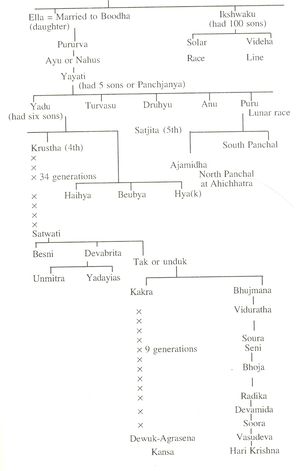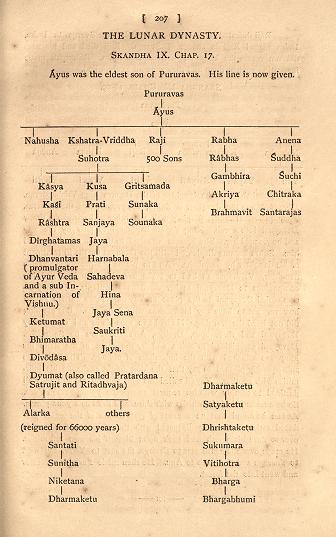
| CHANDRA VANSH Chandravansh, Chandravanshi is one of the types of Kshatriyas. James Tod places it in the list of Thirty Six Royal Races.
History
:
Historians of the Rajput period have called the Ikshwaku group as Surya Vanshi and the Buddha group as Chandra Vanshi, corresponding to the Sun and Moon. Their origin has been linked with Brahma the creator of the universe. The following genealogical tree was drawn out.
Brahma 10 manasputra are Angiras, Atri, Bhrigu, Kratu, Mareechi, Narad, Pulatsya, Pulah, Vashishth and Daksh.
Mareechi had a son Kashyap, Kashyap had a son Vivaswan, Visvaswan had a son Manu and many had a son named Ishvku.
Ikshwaku
Buddh :
Krishna
was born in Chandravansh. Several Kshatriya communities/clans claim
descent from Chandra. One of Brahma's son was Adi, whose son was
Chandra (Som), from whom started Chandravansh.
According to the historian 'Ram Lal Hala' the word Jat is derived from word 'Yat'. There was a king named 'Yat' or Yata in Chandravanshi clan who was ancestor of Lord Krishna. The Jats are descendants of King Yat. 'Yat' later changed to 'Jat'.
Krishna belonged to this branch of the Chandravanshi of Vrishnis from whom he got the name Varshneya.
The Scythian writer Abul Gazi has called himself a Chandravanshi Jat. He also writes that the mother of Scythian community was the daughter of Aila or Ailya Devi.
According to Thakur Deshraj, The Chandravanshi Aryans of India had habitations in Iran which were known as Jatali. He has referred General Cunningham who has mentioned the presence of Yayati Vanshi Jats in Jatali. Yayati was son of Nahusha. This province got the name Jatali being the habitation of Jats. The language of these Jats is Jadgali (alternate names, Jatgali, Jatki, Jat).
Maharaja Bhoj was son of Druhyu, the Chandravanshi Jatvansh King Yayati.
Jat
clans from Chandravansh :
Lunar races in Bhagavat Puran :
Ancestry of Yayati as per Bhagavat Puran
Pururava Ancestry as per Bhagavat Puran Atri → Chandra → Buddh → Pururava → Ayu → Nahush → Yayati
Reference : A study of the Bhagavat Puran; or, Esoteric Hinduism by Purnendu Narayana Sinha, Benares,1901
Bhagavat Puran Skandh IX Chapter 14 tells us about Chandravansh or Lunar races as under :
Som (the Moon) was born out of the eyes of Atri. He carried off Tara, the wife of Brihaspati (Jupiter). Brihaspati asked for his wife several times, but Som would not give her up. Sukra (Venus) was not on good terms with Brihaspati. So he took the side of Som, with his disciples, the Asurs. Shiv with his Bhuts took the side of Brihaspati. Indra with the Devs also sided with their preceptor. The two parties engaged in fight. After some days of fight, Angiras informed Brahma about every thing that transpired. Brahma reproached Som. So he returned Tara to Brihaspati. Brihaspati found that Tara had conceived. "Immediately throw out the seed of another man in my field," cried he. Tara feeling bashful brought forth at the time a lustrous son, Both Brihaspati and Som desired to have the son, each saying "it is mine not yours." When they quarrelled with each other, the Devs and Rishis asked Tara who was the father of the child. The child reproved his mother for the delay in answering. Brahma took Tara aside and learned from her that Som was the father of the son, Som then took the child. Brahma seeing the deep wisdom Of the child named him Buddh (Mercury).
Buddh had by Ila one son Pururavs, Narad related his beauty and his virtues to the Devs in Swarg. Urvasi heard all that and took a fancy for the king. By the curse of Mitra Varun, she had then a human form. Both the king and the Apsaras became attached to each other and they lived as husband and wife. But Urvasi laid down two conditions of her company with the king (i) that the king was to preserve two rams, which the Apsaras had brought with her and (2) that the king was never to expose himself before her except in privacy. Indra sent the Gandharvs in search of Urvasi. They found her out and took away her two rams. She had a maternal affection for these animals and she cried out in despair. The king hurriedly took his arms and ran after the Gandharvas. They left the rams and fled away. The king brought them back. But in the hurry, he had forgot to cover himself and Urvasi left him. The king became disconsolate, and roamed about in search of her. After some days he found her on the banks of the Sarasvati with her 5 companions. He entreated her to come back. She promised to give her company to the king one night every year and informed him of her delicate state of health.
Urvasi
came after a year, with one son. She advised the king to entreat
the Gandharvs for her hands. The king did so and the Gandharvs became
pleased with him. They gave him one Agni-sthali (pot of fire). The
king took the Agnisthali to be Urvasi and roamed with it in the
forest (The Gandharvs gave him the fire for the performance of sacrifice
necessary for the attainment of Urvasi). The king found out his
mistake at last. He then placed the fire in the forest, went home
and meditated every night on Urvasi. On the approach of Treta, he
was inspired with the three Vedas (Karma-kanda). He then went to
the place of fire and found there one Asvatha tree (the sacred fig)
grown from inside a Sami tree (Sami is the name of a tree said to
contain fire). He decided that the fire must be within the Asvatha
tree. He took two pieces of wood (technically called Arani) from
that tree and produced fire by their friction. He- deemed one piece
to be Urvasi and another piece to be himself and the space between
the two pieces to be his son. By friction, the fire called Jata-vedas
came out (Vedas is wealth, enjoyments in general. Jata is grown.
Jata-vedas is that fire from which enjoyments proceed that which
gratifies all sense-desires. It is the chief fire of the Karm-kanda
of the Vedas).
The Lunar races first appeared while the descendants of Ikshvaku were still flourishing, though on the eve of their decline. They had immense possibilities of spiritual evolution, and the great Aryan race seems to be connected with them. The appearance of these races is almost simultaneous with the first flow of the Ganges. For we find Jahnu, who swallowed up the Ganges in her first terrestrial course, is only sixth in the line of descent from Pururavas.
The Lunar dynasty originated in the union of Tara, the female principle of Brihaspati (Jupiter), and the Moon. The issue was Buddh (Mercury), the direct progenitor of the Lunar dynasty.
The son of Budhh was Pururavas. He married Urvasi, the renowned Dev nymph. Pururavas had six sons. But we are concerned with only two of them, Ayus and Vijay. Vijay gave the Adept line of the race and Ayus, the ordinary humanity.
In the line of Vijay, we find Jahnu, purified by the assimilation of Ganga, Visvamitra, pre-eminently the Rishi of the Rig Ved and one of the seven sages who watch over the destiny of the present Manvantar, Jamadagni, another of the seven sages of our Manvantar and Parshuram one of the coming sages of the next Manvantar.
We have already mentioned the part taken by Visvamitra and his sons in the composition of the Vedic Mantras.
Coming to the line of Ayus, we recognise the forefathers of the Aryan races.
In the short-lived branch through Kshatra-vriddh, we find the Vedic Rishi Gritsamad, his son Sunak, the renowned Sounak, Dirghtamas and Dhanvantari, the promulgator of Ayur-veda.
But the longest history of the Race is through the descendants of Yayati.
King Yayati married Devayani, the daughter of Sukra, the presiding Rishi of the planet Venus, and had by her two sons, Yadu and Turvasu. Sukra is the son of Bhrigu, the Rishi of Mahar Lok. Devayana, is the path leading beyond Triloki, after death.
But the King had also connection with a Danav girl, who brought forth three sons, Druhyu, Anu and Puru. For his Danav connection, King Yayati had in youth to undergo the infirmities of age. This evil was transmitted to Puru, the youngest son of the Danav girl.
The line of Puru was short-lived. But it is this line that gave some of the renowned Vedic Rishis, viz. Apratirath, Kanva, Medhatithi and Piaskanva. Dushmant, the hero of Kalidas's renowned drama also came of this line. Vishnu incarnated in part as Bharat, son of Dushmant.
Then there was a revolution. Bharat found that his sons were not like unto himself. So this direct line of Puru came to an end. What followed is a little mysterious. Bharat adopted Bharadvaj as his son. Bharadvaj was begotten by Brihaspati (Jupiter) on the wife of his brother Utathya named Mamata (Egoism).
Bharadvaja is one of the seven presiding Rishis of the present Manvantar. His name is connected with several Mantras of the Rig Ved. The great actors in the Kurukshetra battle were the descendants of Bharadvaj. We find much diversity of spiritual characteristics among them. The material and spiritual forces were gathered together, in all possible grades from the Pandavs downward to the sons of Dhritarashtra and their allies. The poetical genius of the author of the Mahabharat has called forth characters in the Drama of the Kurukshetra battle, that stand out in all the details of real life and find a permanent place in the genealogy of the Lunar dynasty. The study of the racial account of the line of Bharadvaj becomes therefore extremely difficult.
The Lunar dynasty will be revived by Devapi, a descendant of Bharadvaj, who is biding his time at Kalap.
The early inhabitants of Bengal, Behar and Urishya were the sons of Anu, the second son of Sarmistha. The famous Karna, one of the heroes of Kurukshetra, also belonged to this line.
The eldest son of Sarmistha by Yayati was Druhyu. Prachetas of this line had one hundred sons, who inhabited the north as Malechs races.
But
the greatest interest attaches to the line of Yadu, the eldest son
of Yayati by Devayani. The early descendants of this line were the
Haihayas, killed by Parshuram and the Taiajanghas, killed by Sagar
- both of the Solar Dynasty.
The early seceders, the Haihayas and Talajanghas were put down by the Brahman Parshuram and by the Kshatriya King Sagar, who espoused the cause of Vedic Karma Kand and of the Brahmans, represented by Rishi Aurva of this time.
Parshuram did not like any meddling with Vedic Karma Kand by persons not perfected in wisdom. Even Ram had to respect the Vedic Rishis and had to protect them in the performance of Vedic sacrifices from the attacks of Asurs and Rakshashs. When Lord Krishna appeared on the scene, the Asurs still survived; the Vedic Rishis denied offerings to Him, Vedic Karma had a strong supporter in Jarasandh, there was hypocrisy in the name of religion, and there were pretensions in various forms. On the other hand great improvements had been made in the proper understanding of the realities of life and of the laws of nature. Intellect overflowed in many channels of thought, and the religious nature of man found vent in all directions from atheism to religious devotion.
Source
: |


